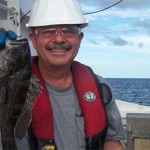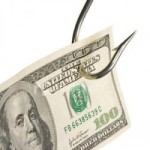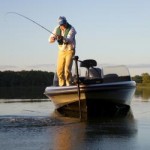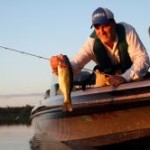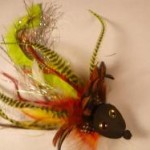How and where to catch middle Georgia Winter Bass
A Chinese proverb says it is better to light a candle than curse the darkness. It is also better to put on warm clothes and go fishing than curse the cold weather. If you sit around and complain about the weather you will miss some good fishing.
You don’t have to be cold while fishing, no matter what the weather. A good snowmobile suit, insulated underwear, snow boots, a stocking cap and a hood will help keep you warm. Add some chemical handwarmers in strategic places and even a propane heater and you can be comfortable.
The best thing to keep you warm this time of year is catching bass. Hook a hog and you will forget the weather. Limit out on three pounders and it might as well be a spring day. And even if you don’t catch much, who would rather sit around in the house than be out fishing?
Cold weather does affect bass but they still have to eat, so you can catch them. Since bass are cold blooded they slow down and don’t eat as much, but they do eat. If you adjust your methods and use the right lures, you can get them to bite.
There are just as many ways to catch bass in January as there are in June, but one thing you must do is slow down. Bass are less likely to chase a fast moving lure this time of year. And they often prefer a small bait over something big in cold water. But you can catch them from the shallows out to the deepest structure if you fish it right.
In the middle of our state three lakes offer excellent bass fishing right now. Jackson, Oconee and Sinclair all have some things in common for catching bass this time of year but each has its own special qualities, too.
Bobby Ferris grew up in Monticello and went to college in Milledgeville, fishing with the Baldwin Backlashers Bass Club during those years. That club fished Jackson, Oconee and Sinclair regularly. After college Bobby has worked in the middle Georgia area for two EMCs and continues to fish this part of the state a lot.
Now Bobby fishes with two Griffin bass clubs, the Flint River Bass Club, where he won seven of 12 tournaments year before last, and the Spalding County Sportsman Club. He also fishes some pot tournaments on middle Georgia lakes and knows them well.
Bobby sold boats at Piedmont Outdoors part time and his affiliation with them and The Sports Center in Perry, as well as his ability to catch bass, got him on Team Triton. He was willing to share some of his tactics for winter bass on the three lakes highlighted here.
I joined the Spalding County Sportsman Club in 1974 and the second tournament I fished was at Sinclair. The third tournament I fished was at Jackson. Four years later I joined the Flint River bass club. Oconee was not even around back then but I watched it being built and both clubs I fish go to those three lakes often. We almost always fish them in the winter.
Last year I won the point standings in both clubs. I have learned some good patterns on these lakes for winter fishing, too, and usually fish in different places than Bobby fishes.
Jackson Lake
Jackson is one of our oldest lakes and has changed over the years. The illegal stocking of spotted bass in the lake means you are likely to catch more but smaller bass there now. Its days of being known for numbers of big largemouth seem to be over. But you can still catch some quality largemouth there and the aggressive spots mean you can catch more fish.
By January the bass have pulled out of coves and set up on main lake points. Rocky points are Bobby’s favorite places to find them now since the rocks hold heat and give the bass a place to hide. Rocks can range from chunk to boulder size, can be found all over the lake and all hold bass. Jackson is small enough that most of the lake is the same in January.
Bobby’s best points are those in the outside bends of the old creek and river channels. He looks for bass holding on them in about six feet of water and feeding at that depth. The colder the weather the better the fishing is on these points for Bobby. A sunny day warming the rocks, with some current moving, is the best.
Tie on a crankbait and a jig and pig and you have what you need to catch winter bass at Jackson. Bobby likes crankbaits like the Rapala DT6, the small Fat Free Shad and a #5 Shadrap for point fishing at Jackson. He will fish one of those crankbaits on the points for more active fish, making several casts across them from different angles.
For clear water choose a shad colored bait and in stained to muddy water go with a bright color. Tennessee shad, natural shad and silver and black are good clear water colors. Chartreuse plugs with orange bellies and blue or black backs, the firetiger color, or crawfish colors are all good when the water is not clear.
If the bass don’t hit a crankbait Bobby will throw an Ol Nelle jig with a Zoom Super Chunk on it. It can be worked slowly in the rocks for the inactive bass. In clear water he picks a green pumpkin jig and trailer and in stained water he goes with a black jig and trailer. He also dips all his jigs in JJ’s Magic clear dip to give them a garlic scent.
At Jackson Bobby fishes crankbaits on 12 to 15 pound Big Game line and his jigs are tied to 25 pound Big Game line. There is always a possibility of a big largemouth or spot at Jackson, and the water is usually stained enough to get away with heavier line.
I like to fish deeper water in the winter and will often jig a spoon or Little George on long points at Jackson. Ride the points from the bridge in Tussahaw Creek to the dam and up the Alcovy River to the Highway 212 Bridge and watch for schools of shad.
The shad are often out over 16 to 20 feet of water, suspended about half way down. If you see fish on the bottom under them, stop and fish. Even if you don’t see the bass they are likely there if the shad are present. Drop a spoon like a Hopkins Shorty or a Little George down, hop it a foot off the bottom repeatedly, and you will find out if the bass are there.
If you see the bass and they won’t hit try deadsticking the spoon or George on the bottom. Let it lay there and barely slide it on the bottom. Don’t raise it off the bottom. That pattern has paid off several times over the years.
I like a short 5.5 foot rod with a fairly light tip but lots of backbone. A fast taper rod allows you to jig the spoon and George easily and feel it but you need the backbone to set the hook and control the fish. I spool up an Ambassadeur 5500c with 15 pound PLine for most of my jigging.
Lake Sinclair
Sinclair has two characteristics that together set it off from all other Georgia lakes. The power plant on the lake dumps warm water into Beaverdam Creek, warming the lake water in that area. And the pumpback at Lake Oconee makes current flow both ways in the lake most days. Both those factors affect bass fishing.
The warm water is so important that Bobby says he always fishes within about a mile of the mouth of Beaverdam Creek in the winter at Sinclair. If he is not in Beaverdam itself he will be on the river near it or just inside the mouth of Rooty Creek, and he fishes Little River up to the bridge. All this area is warmed by the discharge.
On Sinclair Bobby will fish crankbaits on seawalls and docks in shallow water. He stays on the main creek and river runs and does not go way back into coves, sticking with main and secondary points. He is looking for the active bait and bass feeding on it.
Favorite crankbaits are small and Bobby likes a #5 Shadrap, 100 Series Bandit or a DT6. In clear water he goes with Gable Green or natural shad and likes the firetiger color if the water is more stained. He will stick with 12 pound Big Game spooled on a Shimano Calcutta reel on a six foot rod unless throwing the #5 Shadrap under docks, when he will switch to a spinning outfit and lighter line.
If there is some current moving in either direction fishing is better and the moving water will position the bass on the docks and seawalls. Bobby looks for eddies where the bass can hold out of the current and ambush baitfish moving with the current. He says if you run your crankbait by a holding spot, moving it slowly with the current, you should get bit.
If there are several warm days in a row like we sometimes get in January but are more likely in February, Bobby will fish the old dead grass beds. The dead grass holds heat and draws shad to it, and the bass will follow. A spinnerbait run through the grass will draw strikes from those bass.
Jigging spoons work well at Sinclair, too. They tend to be better in clearer water so I will often head to Island or Rocky Creeks at the dam and ride points in them. Long tapering points are best. Watch for the shad down in 15 to 18 feet of water and jig under them for bass.
If there is any brush near the shad, try it, too. You will hang up some but you can usually get a spoon loose by shaking it up and down, working it free. A Little George will not come free so easily. Bass holding in the brush will eat the spoon when it is right in their face even if they won’t move far to chase a moving bait.
On clean bottoms it is hard to beat the Little George. I like a 1/2 ounce George in silver with a silver blade. I drop it to the bottom, tighten my line with my rod tip about a foot over the surface then jig it up and down a foot to two feet.
Move it steadily, not in a jerking motion, and you can feel the blade spin and it rises and falls. Set the hook if the blade stops turning. Most bites will come as the bait falls, so set the hook if the bait does not go back down as far as it should. Keeping your rod tip down near the water allows you to set the hook better when a fish hits.
Lake Oconee m
Oconee is one of our newer lakes and it was dammed in the 1980s. It has become one of our most popular bass fishing lakes, too, with lots of quality bass. The 14 inch size limit with the slot allowing anglers to keep six to 11 inch fish has helped and would be even better for bigger fish if anglers would keep more of the smaller fish.
Since the upper end of Oconee can muddy up fast and the lower lake gets colder water when the pumpback system is running, Bobby concentrates his winter fishing near Brantley’s Marina in the mouth of Lick Creek and the river around it. That area is the most stable on the lake and the bass are easier to pattern and catch consistently.
Most of this area of the lake is lined with nice houses and they all have seawalls. If you look you will see rocks at the water line of many of the sea walls and there are rocks on most others that you can not see. Those rocks are Bobby’s targets at Oconee this time of year. They hold heat and are good cover, too.
Seawalls with deeper water around them, like on main and secondary points, are Bobby’s favorites. He will throw a #7 Shadrap and really likes the jointed version since it is plastic and runs a little deeper, and has a rattle in it. He fishes the crawfish pattern since crawfish call the riprap home and are just about the favorite food of bass.
Throw the Shadrap on 12 pound Big Game line, a six foot rod and Shimano Calcutta reel. Try to bump the rocks as you work the bait across the rocks. If you consistently catch bass very shallow on the rocks, concentrate on making casts right to the bank. If the fish seem to be hitting out on the base of the rocks, make parallel casts to keep your plug in that area longer.
A warming trend at Oconee will pull bass shallow faster than at Sinclair. If you have a few warm days, especially toward the end of the month, shad will move to the very backs of short main lake pockets. Check the pockets if it has been warm and if you see shad activity fish it. Afternoons are usually best, after the sun has had all day to warm the water.
Throw a spinnerbait on the sandy flats in the backs of coves. You will catch bass, hybrids, crappie and even catfish that are back in there eating the shad. You can catch some big bass on this pattern. Bobby likes an Ol Nelle white and chartreuse spinnerbait with one silver and one gold blade for most water conditions. If the water temperature is 55 degrees or warmer in these pockets the shad will be there.
At Oconee I usually head for the dam area this time of year and look for shad on main lake points. Many of them have brush piles on them and the current will move shad across the points. Bass wait in the brush and on clean bottoms to ambush them.
Get right on top of the brush or fish and jig straight up and down. Sometimes bass want a spoon that moves in one place repeatedly. Don’t give up until you have jigged it up and down dozens of times. Try to hit the same place on the bottom, holding your boat in one place and watching your depthfinder. With a transducer on the trolling motor you can often see the fish straight under you and stay on them.
Give these three lakes a try. Fish the patterns in the areas mentioned here and you will catch bass. It it much more fun feeling the fight of a bass on your line than it is sitting at home watching somebody else catch them on TV!
